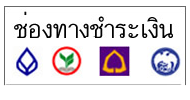The three most expensive gems in the world
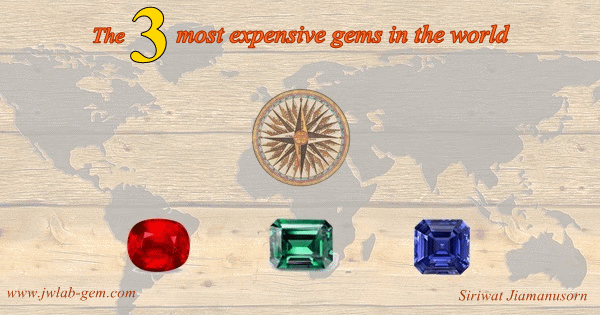
The three most expensive gemstones in the world
Thailand is the country well known as one of the main suppliers for gems and jewellery to the international market. Thanks to the potential resources, skills and craftsmanship in gem cutting and jewellery making, plus the technique of gem enhancement, we have maintained the position of main exporter for years. Nowadays, we take pride in being a regional center for gem study in Asia, where people who are interested in gemology come to Thailand for education. For many years, there has been a significant number of foreigners who come to study gemology in the country. Being the hub of the gem trade center of Asia, specimens of gemstones, both rough and fashioned stones are abundant, so students have the best chance to view a plethora of gems in Thailand than in any other country. A visit to the gem mines, as part of a lesson, is feasible and convenient as most of the mines in the country are easily accessible with standard roads and modern highways. The cost of living here is relatively low when compared to that of Europe or U.S.A. Despite all the advantages we have, it is surprising to note that many Thai people lack the basic knowledge of gemstones. Furthermore, they do not have enough of an interest in gems, especially the colored stones. Besides, those who are interested in gemstones, tend to pay more attention to the diamond. It appears that their knowledge of the diamond is more intensive to that of the colored gems. To cite some experiences, some of my close family and friends informed me that when they came to know of the high price for a big fine ruby, they decided to invest their money in a diamond. A large number of people still believe that the diamond is the most prized and sought after gem. They consider that the value of a particular gem is based on the digits placed on the market price value, rather than that of its intrinsic beauty. The diamond undoubtedly has its own specific visual appeal: being a colorless gem of high luster and dispersion. In contrast, the attraction of the hot red color and brilliance of the ruby cannot be totally disregarded. Somehow people are not aware that a flawless ‘best’ ruby above 5 carats is beyond rare, and it is in the rarity of this type of ruby which constitutes the placement to its value, as an important factor. Nevertheless, each gem should have its own right to be admired for its unique physical, yield value and related lore of provenance. It seems that the colored gemstone trade circle is rather underestimated to that of the diamond which is industrialized as a monopoly with big capital. The cycle of the diamond has the capacity to promote the sale with all its effective means of publicity and advertisement, this being the reason why people are better informed and educated about diamonds rather than colored gems. People‘s knowledge in colored gems is quite restricted, as it is not organized into an industry with big capital, thus the capacity of publicity and advertisement on colored gems is sparse. Let’s take a pause talking of diamonds for a while and get acquainted with 3 colored gems that have been recognized as the most prized gemstones from the past till the present and whose price tends to have a steady growth in the future.
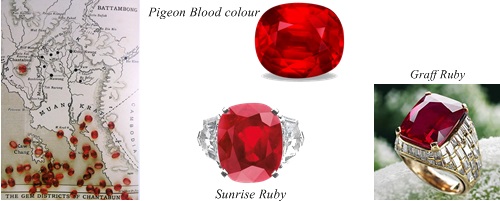
Credit: Christie/Ruby&Sapphire Guide (book)
Ruby
The most expensive of all colored gems is the “ruby” a variety of the corundum family with a hardness of 9 on the Mohs scale (the second hardest gem next to diamond) and the specific gravity is 4. The red color of a ruby derives from the chromium (Cr) as a trace element in corundum. The ruby is the most popular corundum gem and also the rarest variety. Three main factors that govern the price of a ruby, like the other colored gems, are the color, the clarity and the size (weight). The most sought after color in a ruby is the pigeon-blood red. Usually by nature, ruby tends to be fractured with inclusions. Hence a ruby of good clarity for the facetted grade is very rare. The size is the most influential factor of all. The facetted rubies in the gem market in general are mostly found only in small sizes which are called “melee size” (0.20-0.50 carat). A ruby that is bigger than a carat is a rare phenomenon. If the ruby is of a medium size between 1-3 carats, the price multiplies surprisingly many times more than the small ones. A top grade ruby above 5 carat is a world class gem as it is beyond rare, and it is considered as the only colored gem that is more expensive than diamond, when compared to a diamond of the same weight. For example, during the auction at Sotheby’s in Geneva, a flawless pigeon-blood ruby of 8.62 carats was sold at 8,600,401 US$ (approximate 997,727 US$ per carat). It went on record as the most expensive gemstone ever sold.
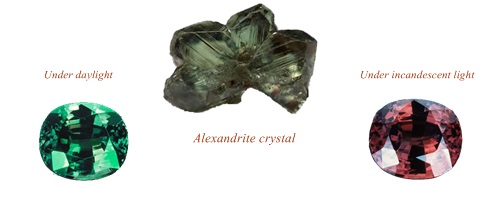
Credit: www.gia.edu.com/geology.com
Alexandrite
The second most expensive gem is “Alexandrite”. It’s quite normal that people are not familiar with this name, as alexandrite is so rare that only a few people could ever have seen it. There is not a significant quantity in the trade either. This legendary gem was discovered in 1834 in Russia and was presented to the King- Czar Alexandra II as a gift on the occasion of his birthday. The first gem of its kind was discovered in an emerald mine in the tract of the Ural Mountains, and at first it was believed to be an emerald of exceptionally good quality, however later it was found to be a completely new type of gemstone. Alexandrite is a variety of chrysoberyl (Be Al2O4) which has a specific gravity of 3.71-3.75 and the hardness of 8.5 on the Mohs scale. Thus alexandrite is considered the third hardest gemstone next to diamond and corundum. The durability of alexandrite is excellent. The visual appeal of this gem exhibits a miracle phenomenon of color change: emerald green in daylight to plum red in incandescent light. It is said that alexandrite is an emerald for the day and a ruby for the night. Such an analogy is not an exaggeration at all. The bi-color of alexandrite coincides by chance with the symbolic color of the Romanov dynasty which is also red and green. The appraisal of alexandrite depends on the rate of the color change effect. If the change of color is very distinct, for example: from emerald green to purplish red, it is the most prized. On the opposite, if the change of color is less distinct, for example: from pale green to greyish purple, then the price drops. Besides Russia, alexandrite is also found in Sri Lanka, Madagascar, Tanzania and Brazil. This gem is so rare that we can selddom see it in the jewellery shop. An alexandrite of high quality demands a prize of a fine ruby.

Blue Sapphire
The third most prized gem is the “Blue Sapphire”. This gem is a variety of the corundum type like the ruby, but of a different color. So the sapphire has the same mineral property as the ruby. The blue color of sapphire derives from titanium (Ti) and iron (Fe) as transition elements in corundum. The sources of blue sapphire are more abundant than ruby. Sapphires are found in India (Kashmir), Sri Lanka, Myanmar, Thailand, Cambodia, Laos, Australia and U.S.A. (Montana). Blue sapphires from different sources are distinct from one another: each mine provides a sapphire of a typical physical characteristic. The appraisal of a blue sapphire, like a ruby, depends on the color, the weight and the clarity. The most coveted one is the saturated blue or so called “Royal Blue” from Myanmar, and the mid-blue slightly tinted with violet called “Cornflower Blue” from Kashmir, the Himalayan tract (India). This cornflower blue sapphire is of such repute that it is termed as “Kashmir Blue”. The legendary Kashmir blue sapphires often appears in the world record as the most priced sapphire. The most expensive sapphire next to the Kashmir blue is the royal blue from Myanmar and Sri Lanka respectively. In the year 2015, a 27.68 carat blue sapphire called “the Jewel of Kashmir” was sold at 6,745,688 US$ in the auction of Christie’s in Hong Kong.
The 3 gemstones analyzed above are the most coveted, hence they are the most prized at all time. What I have presented is only a brief aspect of some precious gems. Actually, there are some newly discovered gems in our century that have also come into fashion and popularity (we will discuss them in the separate articles). If you are interested in the world of gems and plan to collect gemstone, do not hesitate to start as certain gems tend to be scarcer. A good gem is an asset that will never devalue and is the heritage of nature to be transmitted to the succeeding generation.
Siriwat Jiamanusorn (FGA)
คลีนิกอัญมณี
"คลีนิกอัญมณี" เป็นคอลั่มน์รวมบทความต่างๆทางอัญมณีศาตร์ ทั้งที่เกี่ยวกับแวดวงการค้าอัญมณี และในเชิงวิชาการของการตรวจวิเคราะห์พลอยประเภทต่างๆในห้องแลบ ยังรวมไปถึงเรื่องราวอัญมณีที่อยู่ในกระแสความสนใจซึ่งอาจมาจากคำถามที่พบบ่อยเป็นต้น บทความที่ผมเขียนขึ้นจะถูกรวบรวมไว้ในที่นี้ ท่านสามารถติดตามบทความใหม่ของเราที่จะนำเสนอเป็นระยะๆ รวมถึ่งการอ่านเรื่องย้อนหลังได่อีกด้วย
วัฒน์
(หมอพลอย)
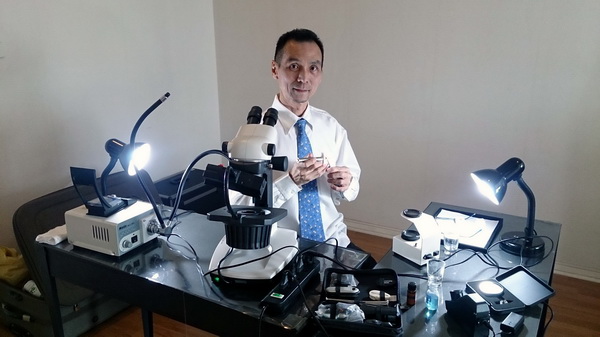

SEARCH
Categories
MEMBER
- ระดับ{{userdata.dropship_level_name}}
- ไปหน้าหลักตัวแทน
- ทั้งหมด {{(order_nums && order_nums.all)?'('+order_nums.all+')':''}}
- รอการชำระเงิน {{(order_nums && order_nums.wait_payment)?'('+order_nums.wait_payment+')':''}}
- รอตรวจสอบยอดเงิน {{(order_nums && order_nums.wait_payment_verify)?'('+order_nums.wait_payment_verify+')':''}}
- รอจัดส่งสินค้า {{(order_nums && order_nums.wait_send)?'('+order_nums.wait_send+')':''}}
- รอยืนยันได้รับสินค้า {{(order_nums && (order_nums.wait_receive || order_nums.wait_confirm))?'('+(order_nums.wait_receive+order_nums.wait_confirm)+')':''}}
- รอตรวจสอบข้อร้องเรียน {{(order_nums && order_nums.dispute)?'('+order_nums.dispute+')':''}}
- เรียบร้อยแล้ว {{(order_nums && order_nums.completed)?'('+order_nums.completed+')':''}}
- ทั้งหมด {{(order_nums && order_nums.all)?'('+order_nums.all+')':''}}
- รอการชำระเงิน {{(order_nums && order_nums.wait_payment)?'('+order_nums.wait_payment+')':''}}
- รอตรวจสอบยอดเงิน{{(order_nums && order_nums.wait_payment_verify)?'('+order_nums.wait_payment_verify+')':''}}
- รอจัดส่งสินค้า {{(order_nums && order_nums.wait_send)?'('+order_nums.wait_send+')':''}}
- ส่งสินค้าเรียบร้อยแล้ว {{(order_nums && order_nums.sent)?'('+order_nums.sent+')':''}}
STATISTICS
| หน้าที่เข้าชม | 370,545 ครั้ง |
| ผู้ชมทั้งหมด | 273,296 ครั้ง |
| เปิดร้าน | 17 ก.พ. 2559 |
| ร้านค้าอัพเดท | 20 ส.ค. 2568 |
CONTACT US
LINK
ติดต่อสอบถาม
 โทรศัพท์: 081-8102763
โทรศัพท์: 081-8102763
![]() LINE ID: siriwat28
LINE ID: siriwat28
 siriwat.jiamanusorn@gmail
siriwat.jiamanusorn@gmail
 Fanpage: @jwlab.gem
Fanpage: @jwlab.gem

TRACK&TRACE

TOP เลื่อนขึ้นบนสุด




